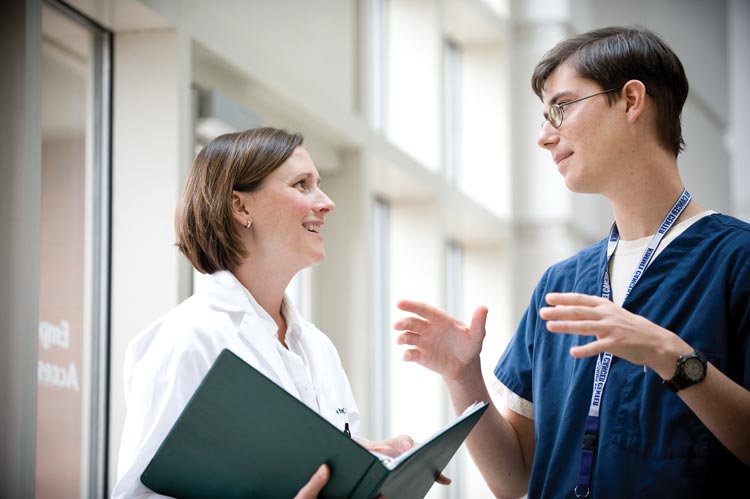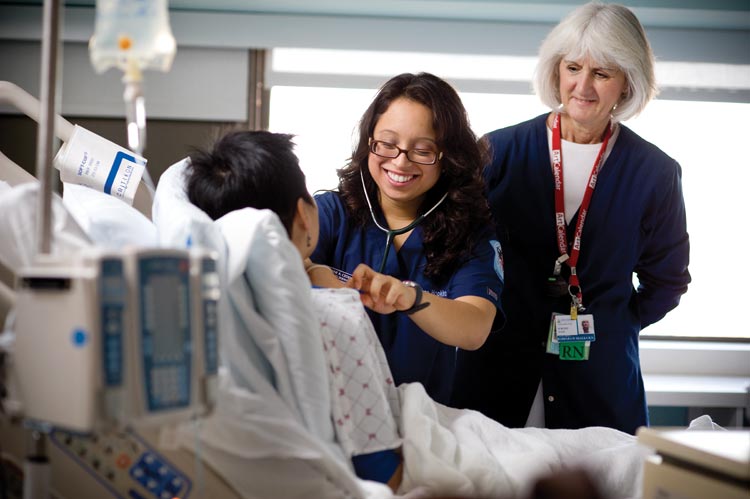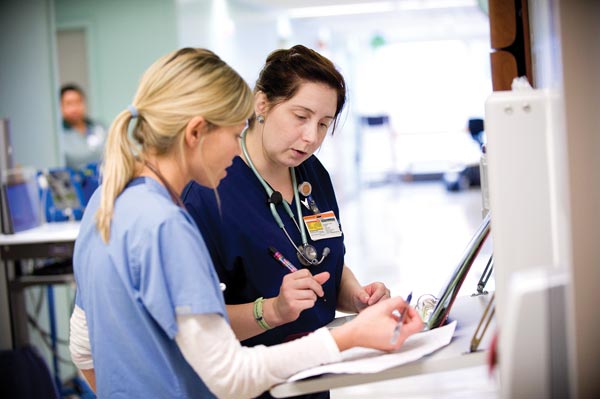by Cate Nielan
Photos by Marshall Clarke
No longer content to absorb information passively in lecture hall after lecture hall, today’s nursing students seek out powerful learning opportunities that call on hearing, sight, sound, and touch; that immerse them deeply in the patient-care experience; and that build that learning through shared experiences.
These active, collaborative learning methods—methods that develop knowledge through experience and communi-cation as much as through the transfer of static information—aren’t new, but recent technological advances in health education, a difficult healthcare market, and a sophisticated, endlessly curious generation of students have demanded that nursing faculty recharge old ways of teaching.
The Times, They Are A-Changing
“Until recently, nursing education hadn’t changed much from when I was a student,” says Dean for Academic Affairs Pamela R. Jeffries, PhD, RN, FAAN, ANEF. “But back then, we were low-tech, with low acuity on the floor. The demands were different.”

Nursing faculty were still teaching primarily through lectures, students groups were still observing a sole instructor on clinical rounds, and opportunities for hands-on education were still limited—but suddenly, graduates were not meeting market needs. “We were finding a gap between what our students could do, and what clinical facilities needed them to do,” notes Jeffries. Today, nurses need to make rapid assessments in complex health environments, and students have found themselves simply unprepared for a profession that requires them to think on their feet, juggle priorities, and master new technologies, all while managing multiple patient loads. As Jeffries points out, “We were challenged as educators to rethink our teaching model.”
Thinking CAPP: Collaborative Clinical Redesign
According to Susan Kulik, MSN, MBA, RN, nurse manager at the Johns Hopkins Hospital, the classic clinical rotation—in which a group of six to eight students observe one instructor through patient rounds—can be frustrating: “Students wait around to do a task because they need a faculty member to supervise. Often, they feel like they’re intruding, and they don’t get to know the staff and the environment.”
[pullquote]
No one was more surprised than Sharon Olson, PhD, RN, AOCN, when an online collaboration exercise among her master’s students resulted in a rich, thoughtful, and scholarly class discussion. Admittedly not a “believer” in online learning, Olsen created a wiki, or collaborative website, for her spring 2010 Synthesis and Integration of Nursing and Business course. But she found that this all-hands approach enabled her students’ sophisticated discussion and “wonderful quality of critique” as they worked in groups to develop a business plan for an imaginary primary care clinic. The wiki discussion format allowed the students to reflect on their readings, find support in the literature, and recommend changes. “The discussion has been at a much higher level. In class, students cannot always articulate their ideas, but [with this method] I’ve noticed that they’re responding in a much more thoughtful, scholarly way. It turns out that I’m really impressed.”
[/pullquote]
In his former hospital administrative role, Jerome Joyner, MHA, RN, a CNS charge nurse at JHH, noticed that this arid, abstracted environment insulated the students from the full nursing experience: “They have their safety net of an instructor, and they’re focused on only one or two patients and their particular task for the week—and then they would move on to their first job. I would get new nurses on the unit, and it was such a culture shock for them to find out that the job wasn’t this structured thing but required a great deal of multitasking and the ability to prioritize your focus and your time.” In 2009, JHUSON established its Clinical Academic Partnership Preceptorship, or CAPP, to change all that.
The program, funded with a Who Will Care? grant from the Maryland Hospital Administration, connects students with professional nurses who are, as CAPP faculty Meg Bernstein, MS, RN, says, “the experts at the bedside, the ones who are problem-solving at the level of real-time practice.”
The CAPP reengineers the clinical rotation design by assigning one or two students to one preceptor (or a preceptor team of baccalaureate-prepared nurse and associate-prepared nurse). JHUSON currently partners with four local hospitals—The Johns Hopkins Hospital, the Johns Hopkins Bayview Medical Center, Howard County General Hospital, and Franklin Square Hospital Center—that each promote a strong educational and professional development focus. “As a magnet hospital,” notes Stacey Danielczyk, RN, a nurse educator at JHH, “one of the values that we instill in our nurses is to become teachers and leaders, so CAPP provides an opportunity for the preceptors to gain those skills.”
Each unit’s nurse manager and nurse educator work carefully to identify the most engaged and committed nurses for the preceptor role. The success of the CAPP program stands or falls on the unique relationship between the preceptor and student; as Jeffries, chair of the CAPP executive team, notes, “There’s no replacement for that level of attention.”
Anna Capp, Traditional ’11, agrees. She credits her preceptor, Maria “Sheilla” Membrebe, MSNE, RN, with her communication skills: “I often get positive compliments on my therapeutic communication both with patients and in simulations, and I must admit, 95% of that is modeled after Sheilla. You can learn the principles in a book, but to actually learn the skills, observing a more experienced nurse do it correctly is so helpful.”
And yet, this teaching-learning collaboration reaches beyond the practical, bedside skills to shape the student’s view of the profession and his or her contributions to it.

Focusing on the Process, not the Tasks
Danielczyk notes that one of CAPP’s most valuable lessons is perspective: “Preceptors become better nurses because they begin to look at the care they’re providing in a different way. They start looking at processes rather than tasks and develop a broader focus for their patient care.” Likewise, shadowing one nurse throughout the day for an entire course allows the students to see the full picture of nursing practice.
As an EMT, Samuel Hoffman, Traditional ’11, had never been further than a hospital entrance before entering JHUSON in the fall of 2009. With Membrebe as his CAPP preceptor during his first semester, he finally got to look behind the scenes at Johns Hopkins Bayview. And it was an eye-opening view that he wouldn’t have gotten anywhere else.
Because Membrebe served as charge nurse, she provided Hoffman with “a very different perspective from what we learn in the classroom. Typically, the classroom focuses on direct patient care, but we got to see how Sheilla organized the overall patient care and prioritized her resources; she provided a running commentary on how it was all put together, on what she was doing and why.”

By opening the spectrum of healthcare to their students, preceptors also expand their professional community. Ghislaine Cedeno, a Traditional ’11 student precepted by Barbara Skalka, RN, at JHH, felt welcomed by the entire healthcare team: “Barbara was my first resource, but I felt comfortable asking questions of all the nurses,” who would give Cedeno the heads up if an especially intriguing procedure, like a chest tube removal, was on. “Even the doctors and physical therapists—all the interdisciplinary areas of the hospital—got involved. They would let you watch and talk with you about what they were doing. It was good to know that, while I was responsible for my patient, I also had this great support network.”
Coordinating a Curriculum
More than just a role model, Membrebe coordinates with CAPP faculty, as well as the other nurses and healthcare professionals in Johns Hopkins Bayview, to design a clinical experience that complements the students’ coursework, appeals to their interests, and builds their confidence. “They get to observe what I really do—how I prepare my reports or check on patients,” but she also ramps up the students’ hands-on experience as they get more comfortable. “We get updates from their instructor on what they can and cannot do. We can let them start doing bed baths and taking vital signs as they cover those areas in class.” The students also stepped up the duration of their day, moving incrementally from a six-hour to a 12-hour shift as their responsibilities increased.
“Sheilla knows everybody and everything that’s going on,” says Anne Capp. Membrebe always directed her to the most exciting patients, even those on other units: “She’d say, ‘There’s something cool going on upstairs—come and see!’” Knowing that the students were interested in wounds, Membrebe arranged a demonstration with the wound care nurse that was a big hit. “They were so thrilled that they got to see all kinds of different wounds,” she remembers. “They had so much fun. They were clapping!”
Affecting Patient Care
“I was really surprised at how much I could help, even as a first-semester student,” admits Hoffman. One of his favorite moments occurred near the end of his CAPP experience, when he was checking in on his last patients. “One man, who had spent the day completely disoriented, suddenly came to himself while I was there. And so I just sat and talked with him for a while. We had a great discussion about why he was in the hospital—I felt like I really helped to bring him back.”
Similarly, Ghislaine Cedeno also remembers translating for a Spanish-speaking patient: “I not only translated for the doctors and nurses to understand his condition, but I was really able to get for the patient the attention that he needed.”
Across the board, it is this sense of active engagement—of belonging to a community that values its members’ work—that fuels the success of the CAPP program. Faculty, students, administrators, and preceptors agree that the students make palpable contributions to the units. “The students have woven themselves into the day and the routine, and the nurses really enjoy them,” reports instructor Kelly Bower, MSN/MPH, RN. Many former CAPP students have even received nursing assistant jobs at the unit, and Bower sees them “mentoring my students, talking them through the experience of that first semester and being great role models for them.”
In turn, the students affect the way preceptors provide their patient care: Valerie L. Barbalace, RN, a preceptor at Franklin Square, admits that “After many years of nursing, you become complacent. But the students keep me on my toes, and it is an educational experience for me, too. They ask me challenging questions, and I have to come up with an explanation. I really have to think about the evidence behind my practice.”
With only three semesters of CAPP complete and one underway, it’s early days for assessing the program’s performance. Always a work in progress, the CAPP program continues to tweak and refine its processes, and the need for trained preceptors continues.
The executive team has spent the last year and a half working closely with the partner hospitals: listening to concerns, brainstorming solutions, and ironing out the complementary roles of the faculty and preceptor. This dialogue and collaboration has been key to the success of the program’s administration. And the experience has proved valuable on an academic program level, too, Jeffries notes: “Working with hospitals allows us to learn what students need on the floor and tailor our curriculum and approaches accordingly.”
| DNP Students Develop Relationships via Technology“I live and work in Mississippi, I spend blocks of time with our transplant program, and I’m a wife and a mom,” says Ashley H. Seawright, ACNP, MSN, DNP ‘10, a nurse practitioner in acute care at the University of Mississippi Medical Center. “A straight classroom environment wouldn’t have worked for me. Without the distance learning technology, I simply wouldn’t have been able to participate in the DNP program at the SON, or have had access to the transplant resources at Hopkins.”Advances in online and voice technology made it possible for post-master’s, professional nurses like Seawright to take distance courses that allowed them to interact in real time with their fellow students and colleagues, while providing two weeks of on-site classes each semester. Seawright came to enjoy the way instructors used the controlled interactive environment to lead discussion while encouraging verbal and written input from the students in real time. The communication technology also allowed the students to collaborate on projects. In particular, Seawright especially appreciated the advantages that the School’s focus on combined distance and in-class learning brought to her DNP experience: “Several people at my institution who attended local or nearby DNP programs didn’t have the two weeks of classroom time that we had—they really missed out on the opportunity to know their peers.” |
| JHUSON Contributes to Multi-site Simulation StudyThis fall, the JHUSON is participating in a multi-site study assessing the efficacy of Harvey, a human-patient simulator, in teaching nursing students to perform cardiopulmonary assessment. The study, led and facilitated by the University of Miami Gordon Center for Research in Medical Education, also provides an opportunity for first-year students to gain hands-on experience with patient care—even if it is only a manikin. Led by faculty member Joyce Vazzano, MS, RN, CRNP, and PhD student Christine M. Keenan, the study includes a three-hour demonstration, as well as open hours for hands-on practice with Harvey, in addition to a didactic lesson. During the demonstration, the students wear stethoscopes with infrared units that allow them to simultaneously observe vital signs. They ask questions, receive feedback, and share and confirm perceptions with the instructor and group in real time. According to Lauren Rubino, a first-year student in the traditional baccalaureate program, “As first-year students, we’re all a little uneasy in our nurse skills, so it was helpful that we were all hearing the same thing and could bounce ideas off each other.”Vazzano and Keenan will re-evaluate the students’ cardiopulmonary assessment knowledge and skills and share their findings with the other study site participants—Pensacola State College, Texas Tech University, the University of Pittsburgh, and the University of Miami. |
| Students Role-play for Patient Safety
They may be low-tech, but role-playing simulations encourage collaboration while teaching communication techniques among healthcare professionals. Funded through the Josiah Macy Jr. Foundation with the Institute for Health Care Improvement, an interdisciplinary simulation study piloted earlier this year. Nursing faculty including Jo M. Walrath, PhD, MS, RN, Hanan Aboumatar MD, and Susan Immelt, PhD, RN, examined the efficacy of the SBAR (Situation, Background, Assessment, Recommendations) method in organizing and conveying essential patient information. Specifically, the researchers wanted to see if role-playing an SBAR–based communication could ensure better patient care and create a more collegial rapport between physicians and nurses. They created a simulation exercise that required groups of four nursing and medical students to assume the roles of the patient presenting atypical symptoms, a family member, a nursing student, and a medical student. Working together, the students implemented the SBAR technique to review the patient’s situation and medical history, perform an assessment, and provide recommendations for action. In this case, the correct recommendation was to refer the case to the medical resident, but the simulation, purposely designed as confusing, required teamwork to move forward.“By putting their heads together and discussing the problem in a standardized way,” notes Immelt, “each was able to realize that they had assessed the problem correctly.” Confirming and communicating perceptions in real time allowed each team to advance their patient’s care effectively. The goal, reports Immelt, is to disseminate this approach to building interdisciplinary rapport. “We’ve found that it works for us at Hopkins, but we want to help other schools build their repertoire of teaching strategies.” |